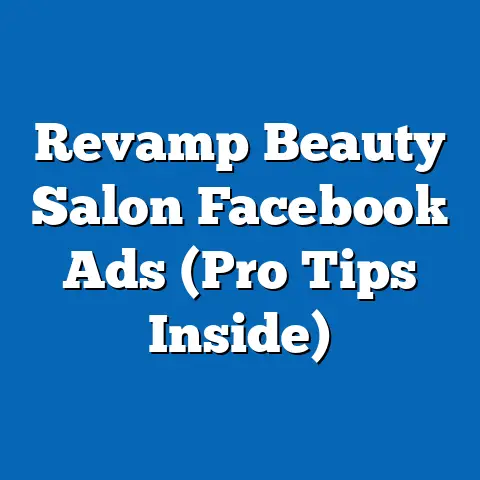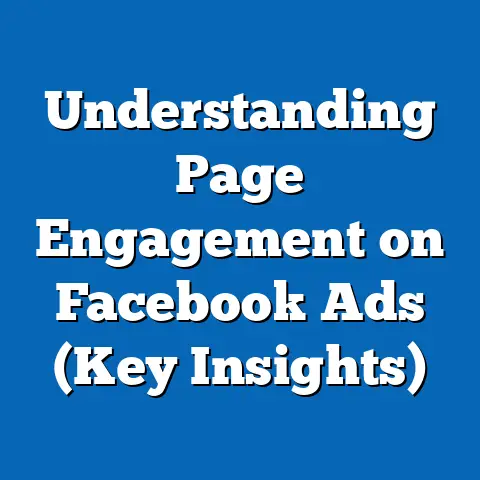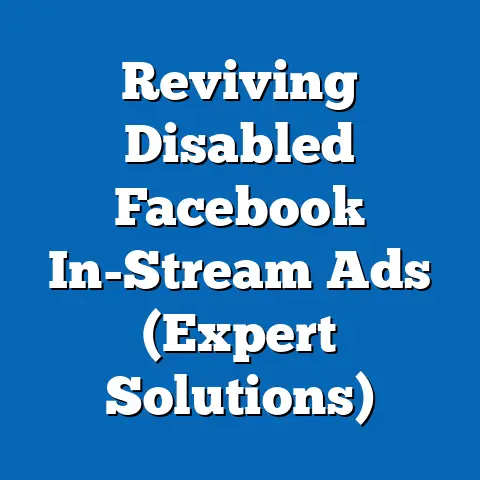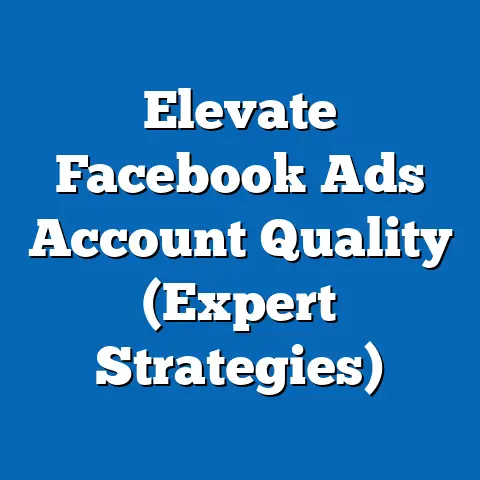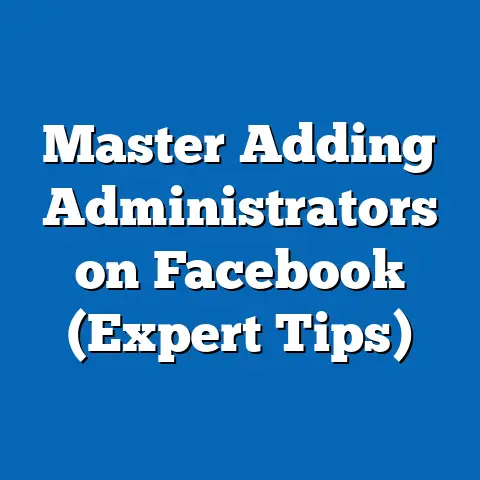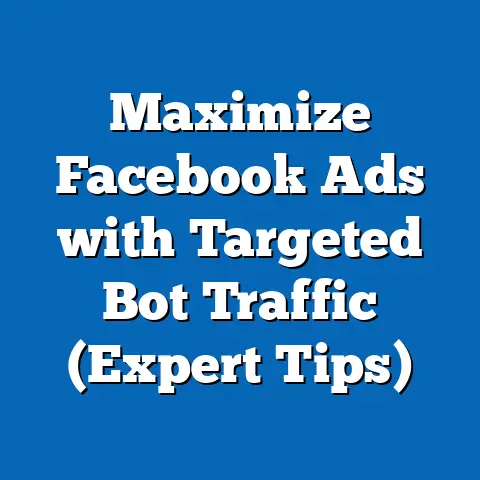Create Compelling Video Ads for Facebook (Proven Techniques)
What if your next video ad didn’t just get views, but actually captivated your audience, turning them into loyal customers within seconds? That’s the power of a compelling video ad on Facebook.
We live in a world saturated with content. Every day, users scroll through endless feeds, bombarded with images, articles, and advertisements. In this digital deluge, video stands out. It’s dynamic, engaging, and, when done right, incredibly persuasive. Over the years, I’ve seen firsthand how businesses, both big and small, have harnessed the power of video on Facebook to skyrocket their brand awareness, drive sales, and build lasting customer relationships.
Think about it. When was the last time you stopped scrolling to read a long text post? Probably not recently. But a captivating video? That’s a different story. The rise of video content on social media, particularly Facebook, isn’t just a trend; it’s a fundamental shift in how people consume information. Statistics consistently show that video content receives significantly higher engagement rates compared to static images or text-based posts. Users are simply more likely to watch a video than to read an article or look at a picture.
Now, I’m not just talking about any video. I’m talking about compelling video ads. Ads that grab attention, tell a story, and leave a lasting impression. Creating these ads isn’t just an option for businesses today; it’s a necessity if you want to thrive in this digital age. It’s about understanding your audience, crafting a message that resonates, and optimizing your videos for maximum impact.
In this guide, I’m going to share proven techniques for crafting effective video ads on Facebook. I’ll walk you through everything from understanding your audience to optimizing your videos for performance, using real-world examples and actionable strategies that you can implement right away. I’ve learned these techniques through years of experience managing Facebook ad campaigns for a diverse range of clients. I’ve seen what works, what doesn’t, and I’m excited to share my insights with you.
So, if you’re ready to transform your Facebook advertising strategy and unlock the power of video, let’s dive in.
Section 1: Understanding Your Audience
Before you even think about shooting a single frame of video, you need to understand who you’re trying to reach. This isn’t just about knowing their age and gender; it’s about understanding their interests, their behaviors, and what motivates them. Knowing your audience is the bedrock of any successful marketing campaign, and it’s especially crucial for video ads. After all, a video that resonates with a Gen Z gamer is unlikely to appeal to a Baby Boomer looking for retirement advice.
Defining Your Target Audience
Facebook offers a wealth of tools to help you define your target audience. Facebook Insights and Audience Insights are invaluable resources for gathering data on your existing audience and identifying potential new customers.
- Facebook Insights: This tool provides data on your Facebook Page followers, including their demographics, interests, and behaviors. It’s a great starting point for understanding who is already engaging with your brand.
- Audience Insights: This tool allows you to explore potential audiences beyond your existing followers. You can filter by demographics, interests, behaviors, and even connections to other pages. This is particularly useful for identifying new target markets and tailoring your video ads to their specific needs.
I remember working with a local bakery that wanted to increase its online sales. They initially targeted everyone within a 20-mile radius, assuming that everyone loves baked goods. However, after diving into Audience Insights, we discovered that their most engaged customers were women aged 25-45 with an interest in healthy eating and organic foods. This insight led us to create video ads showcasing their gluten-free and vegan options, which resulted in a significant increase in online orders.
Beyond these tools, consider your existing customer data. Analyze your website traffic, customer surveys, and sales data to identify trends and patterns. What are your customers buying? What problems are they trying to solve? What are their pain points? The more you know about your audience, the better equipped you’ll be to create video ads that resonate with them.
Creating Audience Personas
Once you’ve gathered data on your target audience, it’s time to create audience personas. A persona is a fictional representation of your ideal customer, based on research and data. Creating personas helps you humanize your target audience and understand their needs and motivations on a deeper level.
Here’s an example of how you might create a persona:
- Name: Sarah Miller
- Age: 32
- Occupation: Marketing Manager
- Location: San Francisco, CA
- Interests: Digital marketing, social media, technology, travel, fitness
- Pain Points: Struggling to keep up with the latest trends in digital marketing, feeling overwhelmed by the amount of content available online, looking for efficient and effective marketing solutions.
- Goals: To improve her company’s online presence, to increase brand awareness, to drive more leads and sales.
Now, imagine you’re creating a video ad for a marketing automation software. Knowing that Sarah is your target audience, you might create a video that highlights how your software can help her save time, streamline her marketing efforts, and achieve her goals. You might showcase real-world examples of how other marketing managers have used your software to improve their results.
Creating multiple personas can be helpful if you have diverse target audiences. Just remember to tailor your video ads to each persona’s specific needs and interests. What resonates with Sarah might not resonate with another persona.
Engagement Metrics
Understanding your audience is an ongoing process. You need to continuously track engagement metrics to refine your understanding of their preferences over time. Facebook Ads Manager provides a wealth of data on how users are interacting with your video ads, including:
- Video Views: How many people watched your video?
- Watch Time: How long did people watch your video?
- Engagement Rate: How many people liked, commented, or shared your video?
- Click-Through Rate (CTR): How many people clicked on the call-to-action in your video?
- Conversion Rate: How many people took the desired action after watching your video (e.g., made a purchase, signed up for a newsletter)?
By analyzing these metrics, you can identify which videos are performing well and which ones are not. You can also gain insights into what types of content resonate most with your audience. For example, if you notice that videos with a humorous tone are performing better than videos with a serious tone, you might want to incorporate more humor into your future video ads.
Key Takeaway: Understanding your audience is the foundation of any successful video ad campaign. Use Facebook Insights, Audience Insights, and your own customer data to define your target audience, create audience personas, and track engagement metrics over time. This will help you create video ads that resonate with your audience and achieve your marketing goals.
Next Steps:
- Use Facebook Insights and Audience Insights to gather data on your target audience.
- Create 2-3 audience personas based on your research.
- Analyze your existing video ad performance data to identify trends and patterns.
Section 2: Crafting a Compelling Message
Once you understand your audience, the next step is to craft a compelling message that resonates with them. This is where storytelling, creativity, and a clear call to action come into play. A compelling message should grab attention, hold interest, and motivate viewers to take action.
The Importance of a Strong Hook
In the fast-paced world of social media, you have mere seconds to capture someone’s attention. The first few seconds of your video are crucial. If you don’t hook viewers within the first 3-5 seconds, they’re likely to scroll on by.
Here are some techniques for creating hooks that grab attention immediately:
- Ask a Question: Start with a thought-provoking question that piques the viewer’s curiosity. For example, “Are you tired of struggling with [problem]?”
- Make a Bold Statement: Open with a surprising or controversial statement that challenges the viewer’s assumptions. For example, “Everything you know about [topic] is wrong.”
- Show a Visual Teaser: Use a visually stunning or intriguing clip to tease what’s to come in the video.
- Highlight a Pain Point: Immediately address a problem that your target audience is facing. For example, “Do you spend hours every week on [tedious task]?”
- Offer a Solution: Promise to solve a problem or provide valuable information. For example, “I’m going to show you how to [achieve desired outcome] in just 5 minutes.”
I once worked with a fitness company that was struggling to get views on their video ads. Their initial videos started with a generic introduction about their gym. We revamped their strategy by starting each video with a quick, visually appealing demonstration of a specific exercise. This immediately grabbed viewers’ attention and led to a significant increase in watch time and engagement.
The key is to be creative and experiment with different hooks to see what resonates best with your audience. Don’t be afraid to think outside the box and try something unexpected.
Storytelling Techniques
Storytelling is a powerful tool for connecting with your audience on an emotional level. People are more likely to remember and engage with a video that tells a story than one that simply presents facts and figures.
Here are some steps for weaving a narrative into your video ads:
- Identify Your Core Message: What is the key takeaway you want viewers to remember?
- Create a Character: Introduce a relatable character who is facing a challenge or pursuing a goal.
- Build Tension: Create a sense of conflict or suspense that keeps viewers engaged.
- Offer a Resolution: Show how your product or service can help the character overcome their challenge and achieve their goal.
- End with a Call to Action: Encourage viewers to take the next step.
For example, let’s say you’re selling a time management app. You could create a video ad that tells the story of a busy professional who is struggling to balance work and personal life. The video could show how the app helps the professional prioritize tasks, manage their time effectively, and achieve a better work-life balance.
Remember, your story doesn’t have to be elaborate or complex. Even a simple, relatable story can be incredibly effective. The key is to create a connection with your audience and make them feel something.
Clear Call to Action (CTA)
A strong call to action (CTA) is essential for driving results with your video ads. Your CTA should tell viewers exactly what you want them to do after watching your video.
Here are some examples of effective CTAs:
- Visit Our Website: “Click the link below to learn more.”
- Shop Now: “Shop our latest collection now.”
- Sign Up for a Free Trial: “Start your free trial today.”
- Download Our App: “Download our app now and get started.”
- Contact Us: “Contact us today for a free consultation.”
Your CTA should be clear, concise, and easy to understand. It should also be visually prominent and strategically placed within your video. Consider using text overlays, animations, or voiceovers to highlight your CTA.
I’ve found that using a sense of urgency in your CTA can be particularly effective. For example, “Shop now while supplies last” or “Sign up today to get a special discount.”
Key Takeaway: Crafting a compelling message is about grabbing attention, telling a story, and providing a clear call to action. Use strong hooks to capture viewers’ attention within the first few seconds, weave a narrative that resonates with them on an emotional level, and tell them exactly what you want them to do next.
Next Steps:
- Brainstorm 5-10 different hook ideas for your next video ad.
- Develop a short story that showcases the benefits of your product or service.
- Craft a clear and concise call to action that motivates viewers to take the desired action.
Section 3: Visual and Audio Elements
The visual and audio elements of your video ads play a critical role in capturing and maintaining viewers’ attention. High-quality visuals, captivating thumbnails, and well-chosen audio can significantly enhance the impact of your video and improve its overall performance.
High-Quality Visuals
In today’s visually driven world, high-quality visuals are a must for any successful video ad. Grainy, poorly lit, or amateurishly edited videos are likely to be ignored or dismissed by viewers.
Here are some tips for ensuring your video visuals are top-notch:
- Use High-Resolution Footage: Shoot your videos in at least 1080p resolution. This will ensure that your videos look crisp and clear on all devices.
- Pay Attention to Lighting: Good lighting is essential for creating visually appealing videos. Use natural light whenever possible, or invest in professional lighting equipment.
- Use a Stable Camera: Avoid shaky or unsteady footage. Use a tripod or stabilizer to keep your camera steady.
- Edit Your Videos Professionally: Invest in video editing software and learn how to use it effectively. Or, hire a professional video editor to help you create polished and engaging videos.
I’ve seen companies completely transform their video ad performance simply by improving the quality of their visuals. Even a small investment in better lighting or editing can make a big difference.
Using Captivating Thumbnails
Your video thumbnail is the first thing viewers see when they encounter your video ad on Facebook. It’s your opportunity to make a strong first impression and entice them to click and watch your video.
Here are some guidelines for designing compelling thumbnails:
Sound and Music
Audio elements, including background music and voiceovers, can significantly enhance the emotional impact of your video ads. The right audio can create a sense of excitement, suspense, or even nostalgia, making your video more engaging and memorable.
Here are some tips on selecting the right audio to complement your visual content:
- Choose Music That Matches the Tone of Your Video: If your video is upbeat and energetic, choose music that reflects that tone. If your video is more serious and contemplative, choose music that is more subdued.
- Use Royalty-Free Music: Avoid using copyrighted music without permission. There are many websites that offer royalty-free music that you can use in your videos.
- Record a Clear and Professional Voiceover: If you’re using a voiceover, make sure it’s recorded in a quiet environment with a high-quality microphone.
- Adjust the Audio Levels: Make sure the audio levels are balanced so that the music and voiceover don’t overpower each other.
I’ve seen videos that were visually stunning but fell flat because the audio was poorly chosen or poorly recorded. Don’t underestimate the importance of audio in your video ads.
Key Takeaway: Visual and audio elements are crucial for capturing and maintaining viewers’ attention. Use high-quality visuals, captivating thumbnails, and well-chosen audio to enhance the impact of your video ads and improve their overall performance.
Next Steps:
- Review your existing video ads and identify areas where you can improve the quality of the visuals.
- Create several different thumbnail options for your next video ad and test them to see which ones perform best.
- Experiment with different types of music and voiceovers to see how they affect the emotional impact of your video ads.
Section 4: Optimization Strategies
Creating a great video is only half the battle. To truly maximize the impact of your Facebook video ads, you need to optimize them for performance. This includes optimizing your video length, testing different formats, and conducting A/B tests to identify which elements resonate best with your audience.
Video Length
Optimal video length for Facebook ads is a topic of much debate. There’s no one-size-fits-all answer, as the ideal length depends on your target audience, your message, and your advertising goals.
However, some general guidelines can help:
- Shorter is Often Better: In general, shorter videos tend to perform better than longer videos. People have short attention spans on social media, so you need to grab their attention quickly and keep them engaged.
- Focus on the First Few Seconds: As mentioned earlier, the first few seconds of your video are crucial. Make sure you capture viewers’ attention immediately and provide a compelling reason for them to keep watching.
- Consider Your Message: If you have a complex message to convey, you may need a longer video. However, try to be as concise as possible and avoid unnecessary fluff.
I’ve found that videos between 15 and 60 seconds tend to perform well on Facebook. However, it’s important to test different lengths to see what works best for your audience.
Facebook Ads Manager provides data on viewer drop-off rates by length. Pay attention to this data to identify when viewers are losing interest in your videos. If you see a significant drop-off rate after a certain point, try shortening your video or making it more engaging.
Testing Different Formats
Facebook offers a variety of video formats, including:
- In-Feed Videos: These are the most common type of video ad on Facebook. They appear in users’ news feeds alongside organic content.
- Stories Ads: These are short, vertical videos that appear in Facebook Stories. They’re ideal for capturing attention quickly and driving immediate action.
- In-Stream Ads: These are videos that play before, during, or after other videos on Facebook. They’re a good option for reaching a large audience and increasing brand awareness.
- Carousel Ads: These allow you to showcase multiple videos or images in a single ad. They’re a great option for highlighting different products or features.
- Collection Ads: These combine a video with a catalog of products. They’re ideal for driving sales and showcasing your product offerings.
The best format for your video ad depends on your goals and your target audience. For example, if you’re trying to reach a younger audience, Stories Ads might be a good option. If you’re trying to drive sales, Collection Ads might be more effective.
Experiment with different formats to see which ones perform best for your business. Facebook Ads Manager provides data on the performance of each format, so you can track your results and make informed decisions.
A/B Testing
A/B testing, also known as split testing, is a powerful technique for optimizing your video ads. It involves creating two or more versions of your ad and testing them against each other to see which one performs better.
Here’s a step-by-step guide on how to conduct effective A/B tests:
- Identify a Variable to Test: Choose one element of your video ad to test, such as the headline, the thumbnail, the call to action, or the video length.
- Create Two Versions of Your Ad: Create two versions of your ad that are identical except for the variable you’re testing.
- Set Up Your A/B Test in Facebook Ads Manager: Use the A/B testing feature in Facebook Ads Manager to split your audience and show each version of your ad to a different group of people.
- Run Your Test for a Sufficient Amount of Time: Allow your test to run for at least a week to gather enough data to draw meaningful conclusions.
- Analyze Your Results: Use Facebook Ads Manager to analyze the performance of each version of your ad. Look at metrics such as video views, engagement rate, click-through rate, and conversion rate.
- Implement the Winning Version: Once you’ve identified the winning version of your ad, implement it in your campaign.
A/B testing can help you identify which elements of your video ads are most effective at driving results. It’s a continuous process of experimentation and optimization.
Key Takeaway: Optimizing your video ads is crucial for maximizing their impact. Optimize your video length, test different formats, and conduct A/B tests to identify which elements resonate best with your audience.
Next Steps:
- Analyze your existing video ads to identify areas where you can optimize the video length.
- Experiment with different video formats to see which ones perform best for your business.
- Set up an A/B test to compare two different versions of your video ad.
Section 5: Analyzing Performance
Creating and deploying video ads is only part of the process. The real magic happens when you analyze the performance of your ads and use that data to make informed decisions about future campaigns. Understanding key metrics and using Facebook Ads Manager effectively are essential for optimizing your video ad strategy.
Key Metrics to Track
Identifying the right key performance indicators (KPIs) is crucial for understanding how well your video ads are performing. Here are some of the most important metrics to track:
- Video Views: This is the most basic metric, showing how many people watched your video. However, it’s important to look beyond just the number of views and consider the quality of those views.
- Watch Time: This metric tells you how long people watched your video. Longer watch times indicate that your video is engaging and holding viewers’ attention.
- Engagement Rate: This metric measures how many people liked, commented, or shared your video. A high engagement rate suggests that your video is resonating with your audience.
- Click-Through Rate (CTR): This metric measures how many people clicked on the call-to-action in your video. A high CTR indicates that your video is effectively driving traffic to your website or landing page.
- Conversion Rate: This metric measures how many people took the desired action after watching your video (e.g., made a purchase, signed up for a newsletter). A high conversion rate indicates that your video is effectively driving results for your business.
- Cost Per Result: This metric shows how much you’re spending to achieve your desired result (e.g., cost per video view, cost per click, cost per conversion). This helps you understand the efficiency of your ad spend.
It’s important to track these metrics over time to identify trends and patterns. Are your video views increasing or decreasing? Is your engagement rate improving or declining? By monitoring these trends, you can identify what’s working and what’s not, and make adjustments to your strategy accordingly.
Using Facebook Ads Manager
Facebook Ads Manager is your go-to tool for analyzing the performance of your video ads. It provides a wealth of data on how users are interacting with your videos, allowing you to track your key metrics and identify areas for improvement.
Here’s a quick tutorial on how to use Facebook Ads Manager to analyze your video ad performance:
- Log in to Facebook Ads Manager: Go to facebook.com/adsmanager and log in to your account.
- Select Your Campaign: Choose the campaign you want to analyze.
- View Your Results: Click on the “Results” tab to view the performance of your campaign.
- Customize Your Columns: Click on the “Columns” dropdown menu and select “Customize Columns” to choose the metrics you want to see.
- Filter Your Results: Use the filters to narrow down your results by date range, demographics, and other criteria.
- Export Your Data: Click on the “Export” button to export your data to a spreadsheet for further analysis.
Facebook Ads Manager also provides a variety of charts and graphs that can help you visualize your data. Take advantage of these features to gain a deeper understanding of your video ad performance.
Iterating Based on Data
The ultimate goal of analyzing your video ad performance is to use that data to iterate and improve your future video ads. This is an ongoing process of experimentation and optimization.
Here are some ways to use performance data to improve your video ads:
- Identify Your Best-Performing Videos: Analyze your data to identify which videos are performing best. What are the common characteristics of these videos? What makes them so effective?
- Identify Your Worst-Performing Videos: Analyze your data to identify which videos are performing poorly. What are the common characteristics of these videos? What’s holding them back?
- Test Different Variables: Use A/B testing to test different variables in your video ads, such as the headline, the thumbnail, the call to action, or the video length.
- Refine Your Targeting: Use your data to refine your targeting and reach a more relevant audience.
- Adjust Your Budget: Use your data to adjust your budget and allocate more resources to your best-performing campaigns.
I’ve seen companies completely transform their video ad performance simply by paying attention to their data and making adjustments to their strategy accordingly.
Key Takeaway: Analyzing your video ad performance is essential for optimizing your strategy and driving results. Track key metrics, use Facebook Ads Manager effectively, and iterate based on data to continuously improve your video ads.
Next Steps:
- Log in to Facebook Ads Manager and analyze the performance of your existing video ads.
- Identify your best-performing and worst-performing videos.
- Develop a plan for using performance data to improve your future video ads.
Section 6: Case Studies and Success Stories
To truly understand the power of compelling video ads on Facebook, let’s delve into some real-world examples and success stories. These case studies highlight how businesses have used the techniques discussed in previous sections to achieve their marketing goals.
Real-World Examples
Case Study 1: A Local Restaurant
A local restaurant was struggling to attract new customers. They decided to invest in video ads on Facebook to showcase their delicious food and inviting atmosphere.
- Technique: They created a series of short videos featuring their most popular dishes, highlighting the fresh ingredients and the chef’s passion for cooking. They also created a video showcasing the restaurant’s ambiance, featuring happy customers enjoying their meals.
- Results: The video ads generated a significant increase in website traffic and online reservations. The restaurant also saw a noticeable increase in foot traffic, as more people were drawn in by the videos.
- Key Takeaway: High-quality visuals and a compelling story can effectively showcase a business’s unique offerings and attract new customers.
Case Study 2: An E-Commerce Store
An e-commerce store selling handmade jewelry wanted to increase their online sales. They decided to use video ads on Facebook to showcase their products and tell the story behind their brand.
- Technique: They created a series of videos featuring their artisans crafting the jewelry by hand. They also created videos showcasing the unique materials they use and the inspiration behind their designs.
- Results: The video ads generated a significant increase in online sales and brand awareness. Customers were drawn to the unique story behind the brand and the high-quality craftsmanship of the jewelry.
- Key Takeaway: Storytelling can be a powerful tool for connecting with customers on an emotional level and driving sales.
Case Study 3: A Software Company
A software company wanted to generate more leads for their sales team. They decided to use video ads on Facebook to showcase the benefits of their software and demonstrate how it can solve common business problems.
- Technique: They created a series of short explainer videos highlighting the key features of their software and demonstrating how it can help businesses save time and money. They also created a video featuring testimonials from satisfied customers.
- Results: The video ads generated a significant increase in leads for their sales team. The leads were also more qualified, as they had already learned about the software and its benefits.
- Key Takeaway: Clear and concise explainer videos can effectively showcase the benefits of a product or service and generate qualified leads.
Lessons Learned
These case studies highlight several key lessons:
- Visuals Matter: High-quality visuals are essential for capturing and maintaining viewers’ attention.
- Storytelling Works: Storytelling can be a powerful tool for connecting with customers on an emotional level.
- Clarity is Key: Clear and concise messaging is essential for conveying your message effectively.
- Call to Action is Crucial: A strong call to action is essential for driving results.
- Analysis is Important: Analyzing your performance data is essential for optimizing your strategy.
Key Takeaway: These case studies demonstrate the power of compelling video ads on Facebook. By using the techniques discussed in this guide, you can create video ads that drive results for your business.
Next Steps:
- Review these case studies and identify the techniques that you can apply to your own video ad campaigns.
- Brainstorm ideas for creating compelling video ads that showcase your products or services and tell your brand story.
- Start creating your video ads and testing them on Facebook.
Conclusion
We’ve covered a lot of ground in this guide, from understanding your audience to optimizing your video ads for performance. Let’s recap the key techniques for creating compelling video ads on Facebook:
- Understand Your Audience: Know their demographics, interests, and behaviors.
- Craft a Compelling Message: Grab attention, tell a story, and provide a clear call to action.
- Use High-Quality Visuals and Audio: Make sure your videos look and sound professional.
- Optimize Your Video Length: Keep your videos concise and engaging.
- Test Different Formats: Experiment with different video formats to see which ones perform best.
- Conduct A/B Tests: Continuously test and optimize your video ads.
- Analyze Your Performance: Track key metrics and iterate based on data.
Remember, creating successful video ads on Facebook is not a one-time effort. It’s an ongoing process of experimentation and optimization. Don’t be afraid to try new things, test different approaches, and learn from your mistakes. The more you experiment, the better you’ll become at creating video ads that resonate with your audience and drive results for your business.
The world of video advertising on Facebook is constantly evolving. New features and best practices are emerging all the time. Stay up-to-date on the latest trends and technologies to stay ahead of the curve.
Video advertising on Facebook has the potential to transform your business. It can help you reach a wider audience, build brand awareness, generate leads, and drive sales. By following the techniques discussed in this guide, you can unlock the power of video and achieve your marketing goals.
So, what are you waiting for? Start creating your compelling video ads today and see the difference they can make for your business. The future of video advertising on Facebook is bright, and I encourage you to take action and implement what you’ve learned. Who knows, your next video ad could be the one that catapults your business to new heights!

